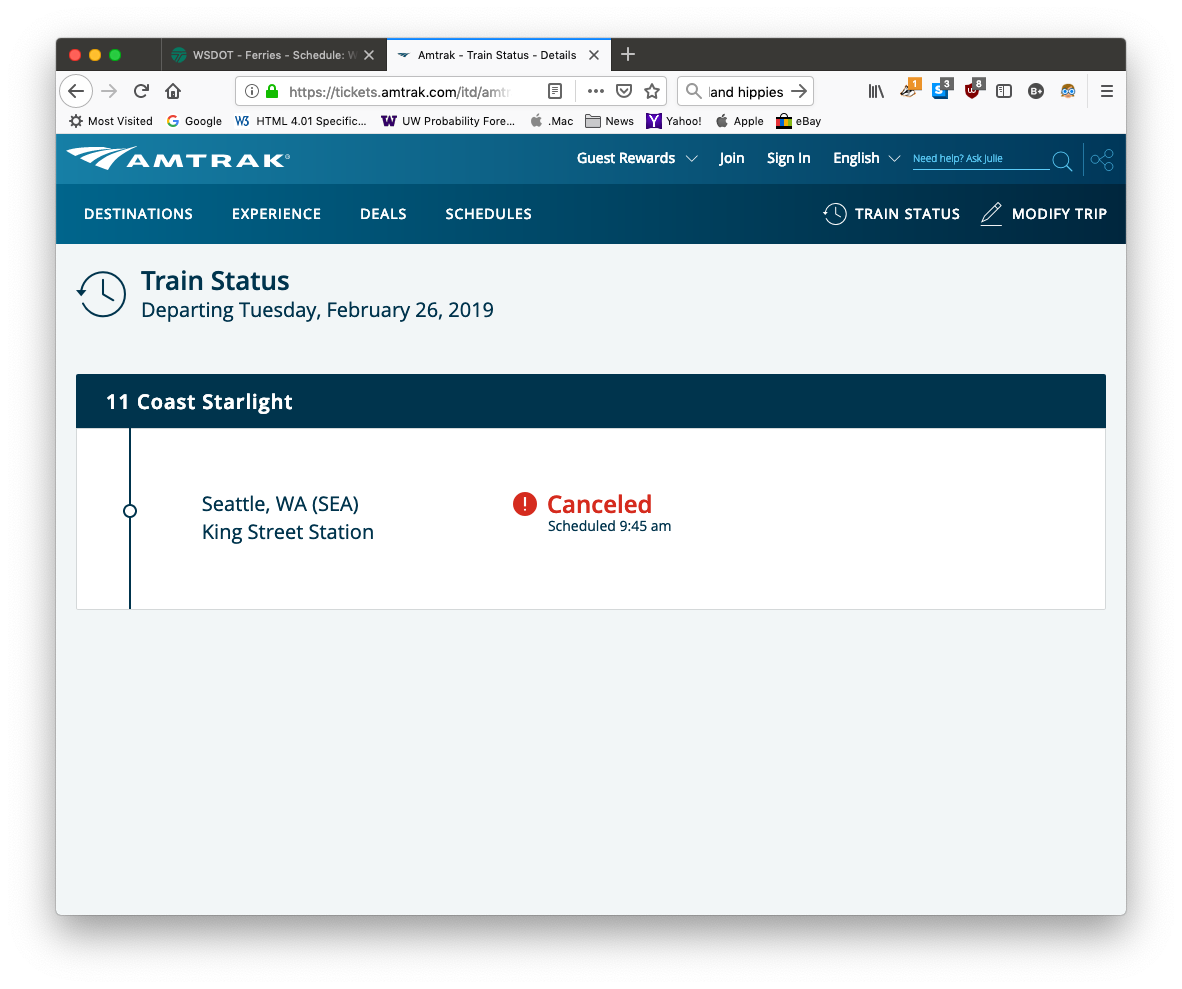Amtrak Is Not a Viable Long-Distance Travel Option
Published at 12:45 on 26 February 2019
 Sorry, railfans. It’s just not. Certainly not in the wintertime between Oakland and Seattle.
Sorry, railfans. It’s just not. Certainly not in the wintertime between Oakland and Seattle.
I just saw off a visiting friend from the Bay Area. He’s taking the bus back home. To get here, he carpooled. He had planned to take Amtrak both ways, but both trains were cancelled due to heavy low-elevation snow bringing down trees on the tracks.
In Europe or Japan, that would simply not have happened. Those trees would have been recognized as threatening the tracks and dealt with (i.e. either logged or pruned) a long time ago. Just in case that failed, there would have been safety procedures in place that allowed them to be promptly cleared and the flow of rail traffic restored.
That’s not how things work in the USA. First, the trees were left to grow, unlogged and unpruned. Then when they came down, there were no procedures in place for dispatching emergency track crews to promptly clear the right-of-way. Even if there had been, there were no modern regulations in place that would have allowed rail traffic to resume promptly.
And really, why should there be either? Amtrak doesn’t own any track in the Western USA. It’s all owned by freight railroads, who specialize in low-priority bulk cargo. It doesn’t much matter if low-priority bulk cargo gets delayed by weather for a day or three. If it did, it wouldn’t be low-priority bulk cargo and it would be shipped by truck.
Truck shipping actually does cost a fair bit more than rail shipping. As, logically, it should: labor cost is much higher. A crew of two can man a freight train of a hundred cars of more. Each of these cars can carry more freight than a single truck (and each truck needs at least one driver). Rail’s labor costs are thus much lower, and that’s before bringing fuel costs (also lower for rail) into the picture.
So why do people ship by truck? Simple: speed and reliability. It’s worth paying a premium for shipments that arrive quicker and with more predictability. Rail is where the less-urgent shipments go, and those tend to be large quantities of low-value-per-unit-weight bulk commodities. The two freight modes have specialized themselves to cater to two separate market segments.
And it is freight modes, because the railroads themselves don’t transport passengers. They have delegated that money-losing business proposition to the nationalized Amtrak.
In Europe, the railroads themselves tend to be nationalized, and to have a public mandate to carry passengers. They control the tracks, and maintain them to significantly higher standards than the US freight railroads do. Passenger rail in Europe is therefore a viable, reliable transport option. Plus, Europe is smaller and more densely-populated than North America, making distances shorter (another factor that works in factor of rail there).
By contrast, in the USA, rail passengers are stuck with a skeletal network typically offering only once-daily service, on lines run by railroads that view renting rail space to Amtrak as at best a necessary evil and more typically as an archaism to be discouraged by being as uncooperative as possible.
Even the much-maligned Greyhound is more reliable than Amtrak. Why? It relies on the highway network, and the latter is publicly owned and does have a public mandate to open promptly and provide reliable service to both private motorists and to motor-freight companies.
The recent snowstorms have been exceptional, and did close I-5, too. The difference is that I-5 reopened within ten hours. The delays for buses, trucks, and private automobiles were much more manageable than the delays for trains.
So, while rail easily can be a reliable mode, in the USA, alas, it is all-too-often not.
